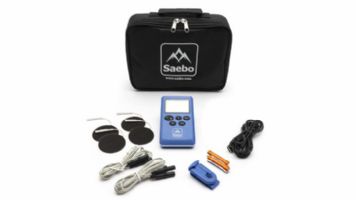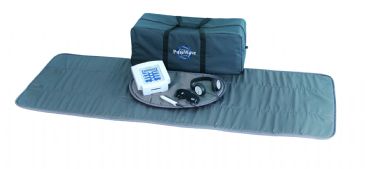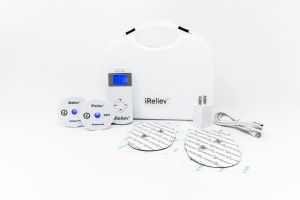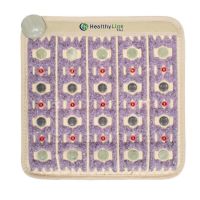 Written by Jessi Cottrell, BSN, RN
Written by Jessi Cottrell, BSN, RN
According to the CDC, in 2016, almost 20.4% of American adults were experiencing chronic pain. With such an astounding prevalence and the ongoing opioid epidemic, healthcare practitioners and patients alike are on the hunt for non-pharmacologic pain management strategies. TENS (Transcutaneous Electrical Nerve Stimulation) and PEMF (Pulsed Electromagnetic Field Therapy) are two such therapeutics that aim to help patients manage their pain through non-medication approaches.
 | SaeboStim Pro | NMES, TENS, and E Stim Machine View Product |
 | PureWave PEMF Full-Body PEMI Mat System View Product |
As mentioned, TENS and PEMF are two frequently used modalities that are applied to promote pain relief. With this similar therapeutic goal, many often confuse the two and fail to differentiate their specific strategies for pain relief and underlying mechanisms of action. Each targets pain from a unique approach and affects different bodily systems and structures. TENS, the first of the two modalities, works through the application of electrical currents whereas PEMF therapy employs applied electromagnetic fields. While TENS temporarily affects the user’s pain perception, PEMF therapy actually works at the cellular level to promote tissue healing, thereby addressing pain as both a symptom as well as the underlying cause.
Recommended: SaeboStim Pro | NMES, TENS, and E Stim Machine
Recommended: PureWave PEMF Full-Body PEMI Mat System
 | Wireless TENS EMS Unit iReliev - Wearable Therapy System View Product |
 | HealthyLine TAJ-Mat PEMF Therapy InfraMat Pro | Small 2020 View Product |
While TENS and PEMF therapy may share some common ground in their treatment goals, they should be differentiated in a number of important ways. In general, TENS provides faster, more localized treatment that focuses on short-term pain relief while PEMF therapy provides a more holistic approach that actually stimulates the body’s healing processes. Follow along as we uncover the inner workings of each to help you find the most appropriate therapy for your treatment goals.
The first primary differentiator of TENS and PEMF therapy is the mechanism of application. TENS is applied using specialized electrodes attached directly to the skin, similar to what you see in most forms of electrotherapy. These electrodes conduct electrical currents from the device into the body and contribute to pain reduction through both exogenous means and endogenous production of dopamine. Often referred to as the “gate-control theory”, the sensory input received from the TENS device overrides pain impulses thereby blocking pain signals from traveling to the brain.
On the other hand, PEMF therapy works by creating electromagnetic fields that combine with the natural magnetic fields in the body to facilitate healing. In doing so, they facilitate healing at a cellular level working with the body’s natural systems to reduce inflammation, expedite recovery, and repair damaged cells and tissues. PEMF therapy devices typically cover a larger area in the body and don’t require direct skin contact to function. While TENS more directly affects the nervous system and pain processing, PEMF works from a cellular level to heal from the inside out.
Both types of modalities can be found in a wide range of devices however TENS units tend to be the most compact and portable. Typically made to fit in your pocket, TENS units are handheld and allow you to both travel and wear the device as you go about your day. Alternatively, PEMF therapy generally comes in the form of a mat, although full-body platforms and paddles also exist. The mats tend to be fairly portable but do require you to lie or sit on them during application, making them slightly less convenient in terms of portable use.
When it comes to healing, we tend to use TENS devices for short-term pain relief purposes. Although it is extremely effective for many, the benefits of TENS tend to wear off shortly after application is completed. It treats pain as a symptom and often provides users with muscular relaxation but doesn’t actually heal the body in any way. On the flip side, PEMF therapy actually targets the cause of the pain from a cellular level, and stimulates the body’s healing processes. Although you may not feel the benefit as immediately as you do with TENS, these intra-cellular changes can result in reduced inflammation and tension in the muscles.
When comparing these two forms of therapies, consider your desired application location. If you are looking to target a specific body part, TENS provides direct, localized stimulation. If you are looking to stimulate the body as a whole and reap system-wide recovery, anti-inflammatory and energy-inducing benefits then PEMF therapy is going to be the better modality. Which therapy you will prefer ultimately depends on what exactly you’re trying to treat.
One of the biggest draws to TENS therapy is the speed with which you will feel results. As soon as the electrodes are applied and the device is powered on, you will start to feel the therapeutic effects almost immediately. While PEMF doesn’t take long to take effect, you just can’t beat the immediacy of TENS.
In terms of cost, TENS units are a great budget option and on average, go for between $100- $200. With a wide variety of options, some devices can be found for less than $50 and some higher-end models with varying current options can be significantly more expensive. While the costs of PEMF therapy mats aren’t outrageous, they do tend to have a higher price point, averaging around $500 with some premium products costing upward of thousands of dollars. If budget is a major concern, TENS units do tend to fall on the inexpensive end as far as health and wellness products go.
Recommended: Wireless TENS EMS Unit iReliev - Wearable Therapy System
Reommended: HealthyLine TAJ-Mat PEMF Therapy InfraMat Pro | Small 2020
With all of this information, choosing the best modality for you will require you to consider all of the above factors. In terms of outcomes, TENS will treat pain as a symptom but PEMF therapy will target the pain at its source, stimulating healing and rehabilitation. If you’re looking for fast treatment or localized short-term pain relief, TENS can be a great option and can be used for both acute injuries and chronic, pre-existing conditions. PEMF therapy, on the other hand, offers a more holistic therapy that gets at the root of the pain and can provide more lasting long-term outcomes. In short, choosing the right modality depends on your condition and your unique wellness goals. Both TENS and PEMF therapy offer excellent options for pain management, recovery, and overall well-being.
With evolving technologies and an ever-growing amount of therapeutic devices on the market, it’s important to understand the underlying mechanisms and goals of different therapeutic modalities. TENS and PEMF are two such modalities that offer users varying approaches to pain management. With unique applications, mechanisms of action, and levels of portability, there are a number of factors to consider when choosing the most appropriate device for you.
For more information on both electrotherapy and PEMF therapies, check out our expert-curated blog, Caregiver University, and make your medical device decisions with the confidence you deserve.

Jessi Cottrell is a Registered Nurse, copywriter, mother, and avid book reader. Her nurse background includes emergency medicine, psych & trauma, orthopedic surgery, addiction detox & rehabilitation, and school nursing. She has a passion for finding non-pharmacological methods to treat pain. This passion is fueled by her experience in addiction medicine as well as her own experiences with pain management after various surgeries.